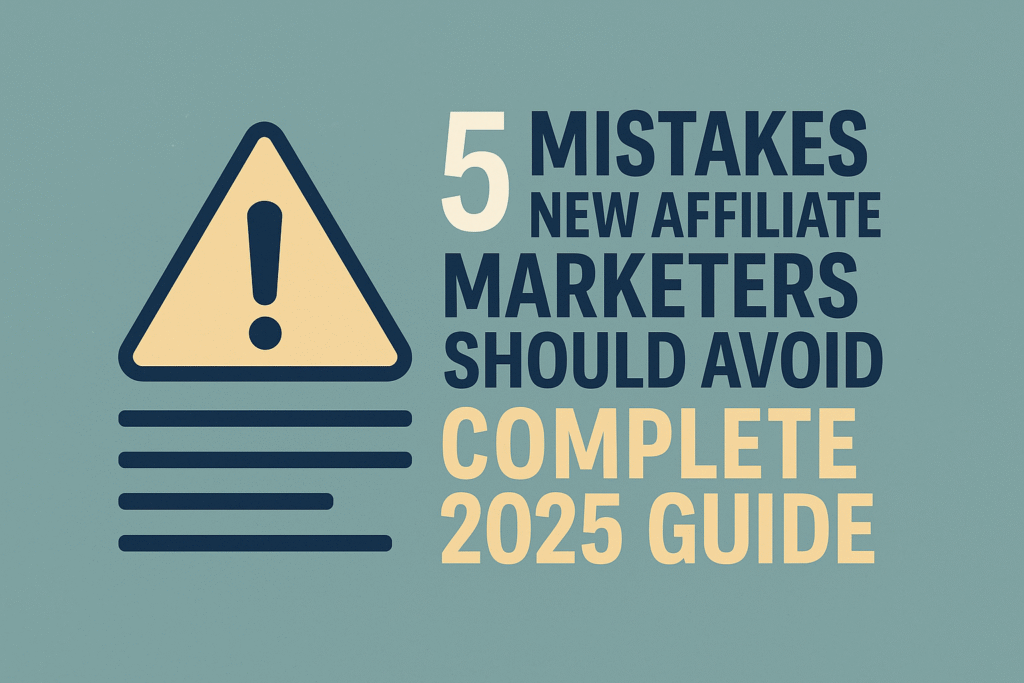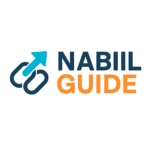5 Mistakes New Affiliate Marketers Should Avoid: Complete 2025 Guide
Affiliate marketing has become enticing for entrepreneurs seeking a flexible and potentially lucrative income stream. It allows you to earn commissions by promoting products and driving business traffic via your unique affiliate links. But while the industry holds immense potential, it’s not without challenges, especially for newcomers.
As a New Affiliate Marketers Mistake Should Avoid, mistakes are crucial to ensure your journey begins on the right foot. This guide identifies five key mistakes to avoid in 2025 and offers practical strategies to overcome them. Whether you’re just starting out or looking to refine your approach, this comprehensive guide will serve as your roadmap to success.

Introduction to Affiliate Marketing
Affiliate marketing revolves around collaboration between advertisers (merchants), publishers (affiliates), and customers. Affiliates earn commissions by promoting the advertiser’s products or services through their content, social media, email campaigns, or websites. While the concept is simple, effective execution requires a combination of research, strategy, and consistency.
In today’s competitive digital landscape, it’s easy to fall into traps that hinder your progress. The mistakes we’ll cover below are the ones most likely to derail your affiliate marketing ambitions if not addressed properly. Let’s dive in!
Mistake #1: Choosing the Wrong Niche
Selecting the right niche is the foundation of your affiliate marketing success. The niche you choose not only determines the type of products you’ll promote but also influences your target audience, content strategy, and long-term growth.
Why This Mistake Happens
Many beginners pick niches based solely on profitability, chasing high commission rates without considering their passion or expertise. Others fail to research the market demand or competition level, leading to wasted time and effort.
Consequences of the Wrong Niche
- Lack of Motivation: Promoting products in a niche you’re not interested in can feel forced, resulting in inconsistent efforts.
- High Competition: Saturated markets make it difficult for new affiliates to stand out, especially without a solid strategy.
- Irrelevant Audience: Without understanding your audience’s needs, your marketing efforts will fail to convert.
How to Avoid This Mistake
- Research Market Demand: Use tools like Google Trends, SEMrush, or Uber Suggest to identify trending niches and search volumes.
- Consider Your Passion and Expertise: Choose a niche that aligns with your interests and knowledge. This will make content creation more enjoyable and authentic.
- Analyze Competition: Look at competitors’ websites, content, and keywords to gauge the difficulty of breaking into the niche.
- Focus on Sub-Niches: Instead of targeting broad categories, narrow down to sub-niches with untapped potential. For example, instead of “health,” consider “plant-based diets for weight loss.”
Mistake #2: Ignoring SEO and Content Marketing
SEO (Search Engine Optimization) and content marketing are the lifeblood of affiliate marketing. Without a clear strategy for driving organic traffic, your affiliate site will struggle to gain visibility and attract clicks.
Why This Mistake Happens
New marketers often prioritize creating content over optimizing it for search engines. They may also overlook the importance of long-tail keywords and fail to produce valuable content tailored to user intent.
Consequences of Poor SEO
- Low Traffic: Without SEO, your website will fail to rank on search engines, leading to minimal organic visitors.
- Unprofessional Appearance: Poorly optimized content can damage your credibility with readers.
- Missed Revenue Opportunities: Limited visibility means fewer clicks and conversions on your affiliate links.
How to Avoid This Mistake
- Perform Keyword Research: Use tools like Ahrefs, Moz, or Google Keyword Planner to identify high-ranking keywords and long-tail phrases in your niche.
- Create High-Quality Content: Focus on producing informative, engaging, and actionable content that addresses your audience’s pain points.
- Optimize Meta Data: Ensure your meta titles, descriptions, and URLs include target keywords for better search engine ranking.
- Build Backlinks: Collaborate with other bloggers, participate in guest posting, and create shareable content to earn backlinks.
- Enhance User Experience (UX): Optimize your site’s loading speed, mobile responsiveness, and navigation to improve rankings and reduce bounce rates.
Mistake #3: Overlooking Analytics and Performance Tracking
Tracking your performance is essential to understand what works and what doesn’t. Many beginners overlook analytics, leading to guesswork and missed opportunities.
Why This Mistake Happens
The abundance of data tools can be overwhelming for newcomers. Some marketers may also lack the technical knowledge to set up tracking systems or interpret data effectively.
Consequences of Poor Tracking
- Inefficient Marketing Spend: Without analytics, you may waste resources on campaigns that don’t convert.
- Missed Optimization Opportunities: Failure to track performance means you can’t improve what isn’t working.
- Inconsistent Growth: Analytics provide the insights needed to scale your efforts effectively.
How to Avoid This Mistake
- Use Analytics Tools: Set up Google Analytics, ClickMeter, and affiliate dashboards to monitor your site’s traffic, conversions, and click-through rates.
- Track KPIs (Key Performance Indicators): Focus on metrics like click-through rates, conversion rates, and average order value.
- Test and Refine: Use A/B testing to experiment with different headlines, layouts, or call-to-action buttons and optimize based on results.
- Leverage Heatmaps: Tools like Hotjar or Crazy Egg can help you understand user behavior and improve your site’s design.
Mistake #4: Overusing or Spamming Affiliate Links
Affiliate links are essential for generating revenue, but excessive use can backfire. Your audience values authenticity and will quickly lose trust if they feel you’re prioritizing commissions over their needs.
Why This Mistake Happens
The eagerness to earn commissions leads many newcomers to overload their content with affiliate links, often without providing valuable context.
Consequences of Link Spamming
- Reduced Audience Trust: Overpromoting affiliate products can make your site feel like a sales pitch rather than a trusted resource.
- Search Engine Penalties: Search engines may penalize sites that appear overly promotional, reducing their rankings.
- Lower Engagement: Readers are less likely to interact with content that feels overly sales-driven.
How to Avoid This Mistake
- Focus on Value-Driven Content: Prioritize creating content that educates, entertains, or solves problems for your audience.
- Use Affiliate Links Sparingly: Place links only where they’re relevant and beneficial to the reader.
- Disclose Partnerships: Build trust by being transparent about your affiliate relationships.
- Diversify Monetization Strategies: Supplement affiliate marketing with other income streams, such as display ads, sponsored posts, or selling digital products.
Mistake #5: Neglecting Email Marketing
While many beginners focus on attracting traffic to their website, they often overlook email marketing—a powerful tool for nurturing leads and driving repeat conversions.
Why This Mistake Happens
New marketers may underestimate the potential of email marketing or struggle to build a mailing list. Others may lack the technical know-how to set up effective email campaigns.
Consequences of Neglecting Email Marketing
- Lost Engagement Opportunities: Without email, you miss the chance to build relationships with your audience.
- Reduced Repeat Conversions: Email campaigns can remind subscribers of your affiliate products and drive repeat purchases.
- Limited Audience Retention: Unlike website visitors, email subscribers provide a direct line of communication for long-term engagement.
How to Avoid This Mistake
- Start Early: Build your mailing list from the outset by offering incentives like free eBooks, checklists, or exclusive content.
- Use Email Marketing Tools: Platforms like Mailchimp, ConvertKit, or AWeber make it easy to design and automate campaigns.
- Segment Your Audience: Personalize your emails based on user interests or behaviors for higher engagement.
- Provide Value: Focus on delivering helpful content, tips, and product recommendations rather than hard-selling affiliate links.
Conclusion
Starting your affiliate marketing journey can feel like navigating uncharted territory. However, avoiding these common mistakes can set you up for success in 2025 and beyond. Remember: the key to sustainable growth lies in building trust with your audience, refining your strategies through data-driven decisions, and staying updated with industry trends.
Affiliate marketing rewards those who approach it with patience, persistence, and a willingness to learn. Avoiding the pitfalls outlined in this guide will help you establish a strong foundation and achieve long-term success in this dynamic field.






